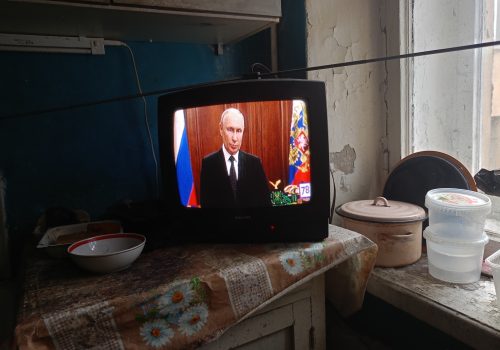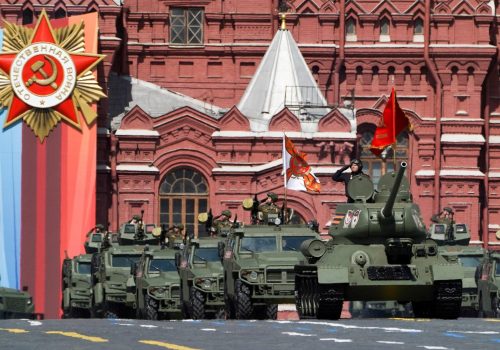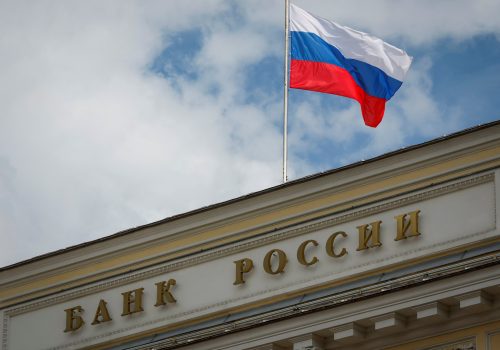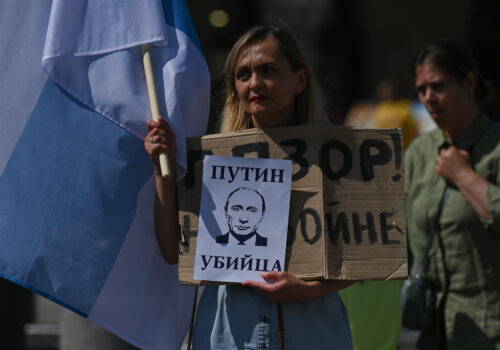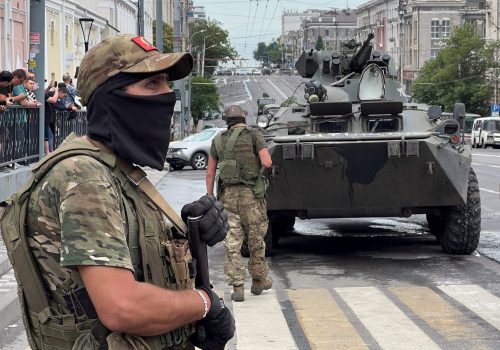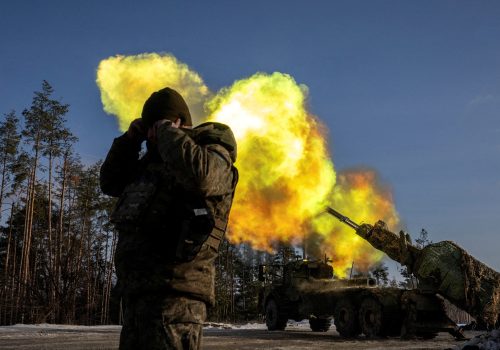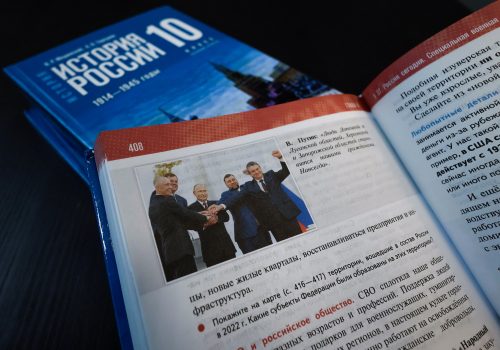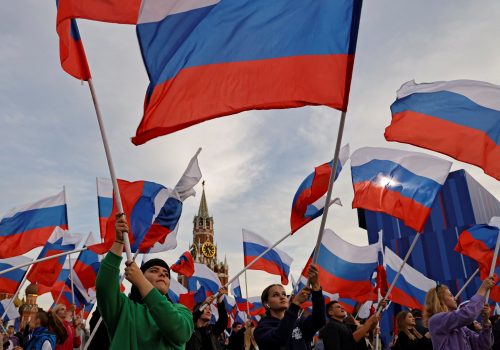Russia Tomorrow: Five scenarios for Russia’s future

Russia’s full-scale invasion of Ukraine in February 2022 challenged much of the common Western understanding of Russia. How can the world better understand Russia? What are the steps forward for Western policy? The Eurasia Center’s new “Russia Tomorrow” series seeks to reevaluate conceptions of Russia today and better prepare for its future tomorrow.
Imagine Russia in 2030. Will it resemble today’s imperial kleptocracy? Will it be a Western-style democracy? Will the Russian Federation exist at all? As Russia’s unprovoked invasion of Ukraine continues, the questions of what comes next have never been more pertinent. However, while questions of future developments in Ukraine continue to dominate discourse in places like Washington and Brussels, far less attention has been paid to what comes next in Moscow, and across the Russian Federation. Indeed, the discussion of developments within—and policy surrounding—Russia’s potential future has been largely muted across the West. Even after former militia head Yevgeny Prigozhin’s failed 2023 putsch, serious discussion regarding potential Russian futures remained largely subdued.
But given the magnitude and fallout of Russia’s invasion, to say nothing of the ongoing threats that a revanchist Kremlin poses to the West and its allies elsewhere, this lack of discussion surrounding Russia’s potential future is increasingly inexcusable. As such, this essay will seek to rectify that inadequate oversight in the broader policy conversations about Russia’s path forward.
Briefly, the five scenarios detailed below include:
- Putin’s continued rule
- Putin’s ouster, followed by the installation of a far-right, nationalistic figure or cadre
- Putin’s ouster, followed by a technocratic, if still largely antidemocratic, regime
- Putin’s ouster, followed by the rise of a liberal, thoroughly pro-Western government
- Russian Federation state fracture
These sections include potential developments leading to and through each scenario—imagining what such a scenario would entail—as well as how the West should respond strategically if the scenario comes to pass, as well as potential time horizons.
These scenarios should not be taken as necessarily exhaustive. Instead, these five scenarios should be treated as the five likeliest scenarios moving forward.
All five scenarios should be considered within Western capitals—and attendant policy tool kits should begin to be formulated in preparation of each potential scenario. While this will require efforts and exertion from Western policymakers, such efforts are necessary. After all, if there is one thing the rise of Putin’s regime has illustrated, it is that the West’s lack of broader Russian strategy—and the lack of preparation for potential openings in Russia—helped accelerate Moscow’s aggression and helped fuel the Kremlin’s irredentism. The more prepared the West can be for potential openings and potential evolutions in Russia moving forward, the better off all of us—including those in Russia—will be.
Explore the five scenarios
Scenario #1: Long live President Putin
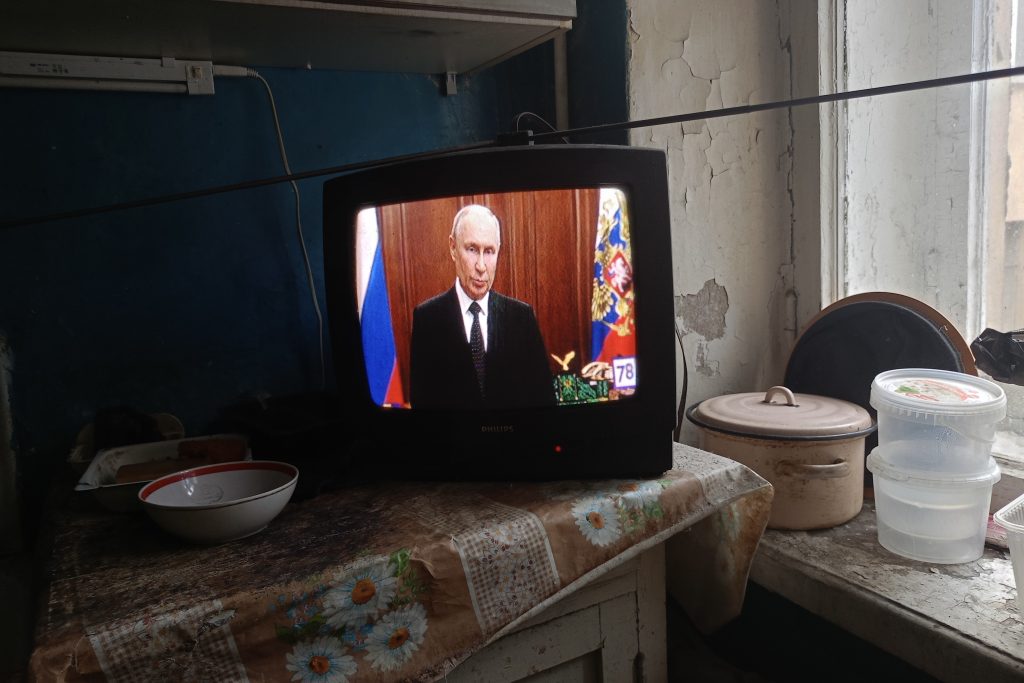
Details: Following Russia’s expanded invasion of Ukraine in 2022, and the immediate quagmire and myriad failures Russia encountered, many observers in the West were quick to predict Putin’s downfall. And understandably so. Not only have bungled wars—from the Crimean War and Russo-Japanese War to World War I and the invasion of Afghanistan—long preceded significant political shifts in Moscow, but the immediate salvo of sanctions threatened to bring the Russian economy to its knees.
And to be sure, there have been costs: tens and potentially hundreds of thousands of dead Russian fighters, all without achieving even the barest Russian strategic goals in Ukraine; an overheated economy hurtling toward autarky; a looming nationwide mobilization, with the prospect of martial law on the horizon; all while Russia watches its geopolitical import crumble from the Caucasus to Central Asia. Putin’s unprovoked invasion is, in many ways, the greatest unforced geopolitical error Moscow has seen in decades—and potentially ever.
And yet, years after Russia first invaded Ukraine, the status quo in the Kremlin prevails. A cowed Russian populace refuses to march for anything other than local concerns. Saturated in a mixture of apathy and fear—and for a good chunk of Putin’s base, even support for a revanchist war—Russians refuse to move against the regime.
In the Kremlin, Putin continues to pursue the same domestic strategies he and his inner circle have perfected for a quarter of a century: jailing or exiling opposition figures, obliterating opposition media, and gathering more levers of power to the Kremlin itself. Putin’s moves toward outright dictatorship, and even totalitarianism, continue apace. Even while the Russian military sputters in Ukraine, and while the specter of a frozen conflict emerges across southern Ukraine, Putin’s grip on power strengthens. As Putin sees it, if the status quo can prevail, then so will he.
And so, Russia and its war in Ukraine slog on. Putin continues mortgaging Russia’s future because of his monomaniacal obsession with Ukraine, and bets on a Western alliance fracturing. And while it’s no guarantee for victory, it’s hardly a bet he is guaranteed to lose—especially if, in January 2025, former US president Donald Trump, who has refused to commit to backing Ukraine against Russia, returns to power and cuts off aid. This would in effect allow Putin the dominance of former Russian colonies that he has long craved.
Strategy and policy prescriptions: The strategy for such a potential outcome is relatively simple, entailing a continuation, expansion, and enhancement of the current slate of policy prescriptions. The current administration, as well as future administrations, should build on President Joe Biden’s recent Oval Office speech, making it clear that the US objective is containing an expansionist Kremlin, both to secure core US interests and to send a message to China not to touch Taiwan.
More specifically, such policies should include the expansion and strengthening of the current sanctions regime. Likewise, this includes the consideration of the expansion of secondary sanctions designations and leaning on nations like Turkey, India, and the United Arab Emirates to follow Western sanctions programs or face potential consequences. Further, this policy entails the strengthening of the price cap on Russian hydrocarbons, as well as the Group of Seven-led seizure of frozen Russian Central Bank assets, which can be rerouted to Ukrainian reconstruction efforts. In the security space, Western policymakers should pursue the increase of NATO forward operability capacity in Eastern European partner nations, as well as enhancing NATO-based security relationships with non-NATO partners, such as Bosnia and Kosovo.
In Ukraine, this entails an expedited path to European Union membership, as well as continued expansion and formalization of security partnerships and armaments shipments, focusing on providing the Ukrainians the tools required to fully succeed in defending their nation against Russian aggression. Elsewhere, the West should increase support to other nations targeted by Russian nationalists, including Moldova and Kazakhstan, so long as such assistance is predicated on democratic reforms (especially in the latter). Most broadly, this entails assuring partners elsewhere, especially in Kyiv, that the West will continue to support Ukraine’s efforts until every inch of Ukrainian territory is restored to Ukrainian sovereignty.
So long as Putin remains in power, Russia’s unprovoked war will continue, with designs on far broader conflagration. The West must use every tool it can find to force Russians—both those in the Kremlin and the broader populace itself—to realize the futility of Putin remaining as president.
Time horizons and likelihood: In the coming few years, and barring any unforeseen health concerns for Putin, this scenario is unfortunately the likeliest of the grouping presented in this paper. Given the endogenous factors in Russia—not least the lack of domestic pushback, even after Russia has seen more casualties than anything experienced since World War II—there is little reason to think that Putin cannot continue for the foreseeable future, so long as he faces no clear military defeat in Ukraine. While the Russian economy has shown clear struggles, it hardly appears near collapse.
Indeed, Putin’s strategy of simply waiting out the West is, presumably, his likeliest path to outright victory, not least considering the outlook for the US 2024 presidential election. And it is a strategy that must be shown to fail. The West must stand united, and must stand by Kyiv, regardless of the time horizon. The alternative would present a precedent devastating to stability in Europe, as well as globally—not least that it would illustrate that a nuclear-armed power can successfully invade, devastate, and carve up nonnuclear neighbors, including those that have already given up their nuclear arsenal.
Putin, in other words, may yet get the “long war” he desired. But he cannot—and must not—win.
Scenario #2: Nationalists rising
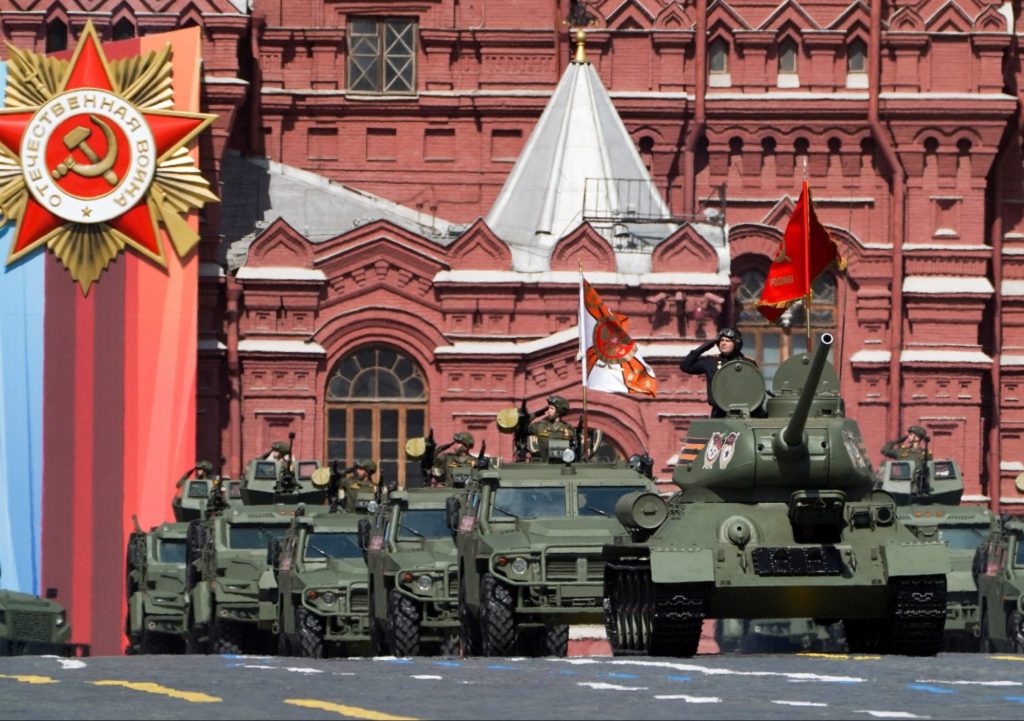
Details: In June 2023, Putin faced arguably the greatest threat to his grip on power yet seen. Led by caterer-turned-warlord Yevgeny Prigozhin, members of the Wagner Group private military company effectively took control of the southern Russian city of Rostov-on-Don, before marching hundreds of kilometers toward Moscow. While the forces themselves never reached the Kremlin—and significant confusion remains regarding the march’s ultimate objective—the quasi-mutiny, quasi-putsch revealed just how thin the base of Putin’s support appeared. That is, even while Wagner forces hauled north, few Russians appeared willing to stand in their way. To butcher a phrase, the emperor may not have been naked, but he certainly appeared with far fewer clothes than previously assumed. This reticence to back Putin was made all the more stark by Prigozhin’s previous comments on the war in Ukraine, which slammed not only Russia’s military leadership but the entire rationale for invasion in the first place.
Of course, by late 2023, Putin remained in power, while Prigozhin and his inner circle exploded in spectacular fashion. Yet even with Prigozhin’s death, the shallowness of Putin’s support is not something that can simply be forgotten or washed away. Moreover, combined with Putin’s increasingly obvious strategic blunders in Ukraine—and the climbing death tolls as well as ongoing assaults on Russian territory proper—there’s little reason to think he’ll manage to shore up that support anytime soon.
All of which presents a recipe, and an opening, for success for the one contingent that has becoming increasingly vocal and increasingly strident in its criticisms of Putin’s leadership: Russian nationalists. Indeed, while some had seen Prigozhin as perhaps the most prominent far-right figure—and certainly the one who illustrated what such a contingent can achieve, both domestically and internationally—other prominent Russian nationalists persist within and outside the Kremlin.
Indeed, it’s not difficult to imagine a scenario in which Putin, beset and besieged over his continued failings in Ukraine, finds his domestic support continuing to waffle, and even potentially crumble. This is a man, after all, who wagered Russia’s future on an historically futile, stupid gesture. And everyone, despite the best efforts of Russian propaganda organs, can see it. Meanwhile, the Russian body politic has begun fracturing: frustrated veterans committees have expanded; unemployed Russian youths increasingly gravitate toward nationalistic rhetoric; and local politicians unable to pay for basic services turn toward a nationalistic populism to remain in power.
Unlike the last time Russia experienced a far-right coup attempt—in 1991, following the Soviet KGB’s failed effort to depose Mikhail Gorbachev—there is a clear constituency willing, even happy, to welcome the rise of a nationalistic regime to replace Putin’s kleptocracy. Such a scenario, thanks to Prigozhin, can no longer be dismissed. And should it succeed, it will replace Putin’s fascistic lurch with outright Russian fascism—predicated on restoring a mythical Russian “nation,” and targeting all enemies both domestic and foreign. The notion of a rossiskii nation-state—of a broader, heterogenous Russian Federation—would be summarily replaced by a focus on the russkii ethnos, and on a restoration of a purified, sacrosanct, ethnically Russian people.
Russia, these nationalists claim, will rise once more. Putin may have had the right designs, but he was too weak or too corrupted to see such a project to its completion. Now, these nationalists argue, they can restore Russia to its rightful place—and ethnic Russians to their rightful glory.
Strategy and policy prescriptions: As with the scenario in which Putin remains ensconced in power, the broader strategy and policy playbook for the rise of a far-right, nationalistic regime in Russia remains largely the same. The continuation and extension of sanctions; the retention of a price cap on Russian hydrocarbon exports; the seizure of Russian Central Bank assets as a means of funding Ukrainian reconstruction; the enhancement of NATO forward operability; and more. All the policy prescriptions outlined in Scenario #1 are applicable to Scenario #2—because any nationalistic regime will share broadly similar geopolitical contours and theories as Putin, especially as it pertains to a (perpetual?) standoff with the West.
Given the paucity of resources available to the Russian military, a rising nationalistic regime may, at least in the short term, prefer to freeze the conflict in Ukraine, if not pull back from certain pockets. Without the legitimacy of political capital to call for a nationwide mobilization, such a nationalistic regime may opt to avoid escalation with Ukraine and the West, while pinning the strategic failures in Ukraine on Putin.
Such a stand-down would provide ample opportunity for the West to expand its existing playbook, especially as it pertains to shoring up Ukrainian arms and defenses. Likewise, and arguably more so than if Putin simply remains in power, such a scenario would present the West with far greater openings to rebuilding and shoring up relations with Russia’s neighbors, especially those targeted by Russian nationalistic rhetoric. From Belarus to Georgia, from Armenia to Kazakhstan, the West can focus diplomatic and, to an extent, security-related efforts on strengthening links with these nations.
All the while, the West must recall that any such regime in Russia will only turn inward for a set period. Such a pullback—in Ukraine or elsewhere—would only be temporary, presenting a mere lull in conflicts in Europe. A quasi-détente could arise, but it would hardly last. And the West must prepare for when that détente crumbles and such nationalists turn outward once more. If anything, such a prospective reality harkens back to a strategy that once served the West well: containment, for as long as the regime may remain. After all, containment helped to hem in Soviet expansionism—and could once more help to rein in an expansionist Moscow.
Time horizons and likelihood: Given Prigozhin’s failure—and the consequences of such failure, not least his spectacular death—the likelihood of such a rightward putsch is arguably less than it was just a year ago. It also is possible that some would-be kings conclude from the Prigozhin affair that his mistake was not launching the coup, but calling it off. But even if the possibility of a coup has diminished, such a threat has hardly been eliminated. Absent other unanticipated events, it remains arguably the second-likeliest scenario over any time horizon. Indeed, as the Russian economy continues to deflate, and especially as Russian casualties continue to pile up in Ukraine, the likelihood of such a scenario increases over time.
Put another way: as Russia continues to fail and flail in Ukraine, the potential for a “stabbed in the back” scenario only gains ground. And it is that failure narrative that nationalists would use against Putin—and as a propellant to potential power, for years to come.
Scenario #3: Technocratic reset
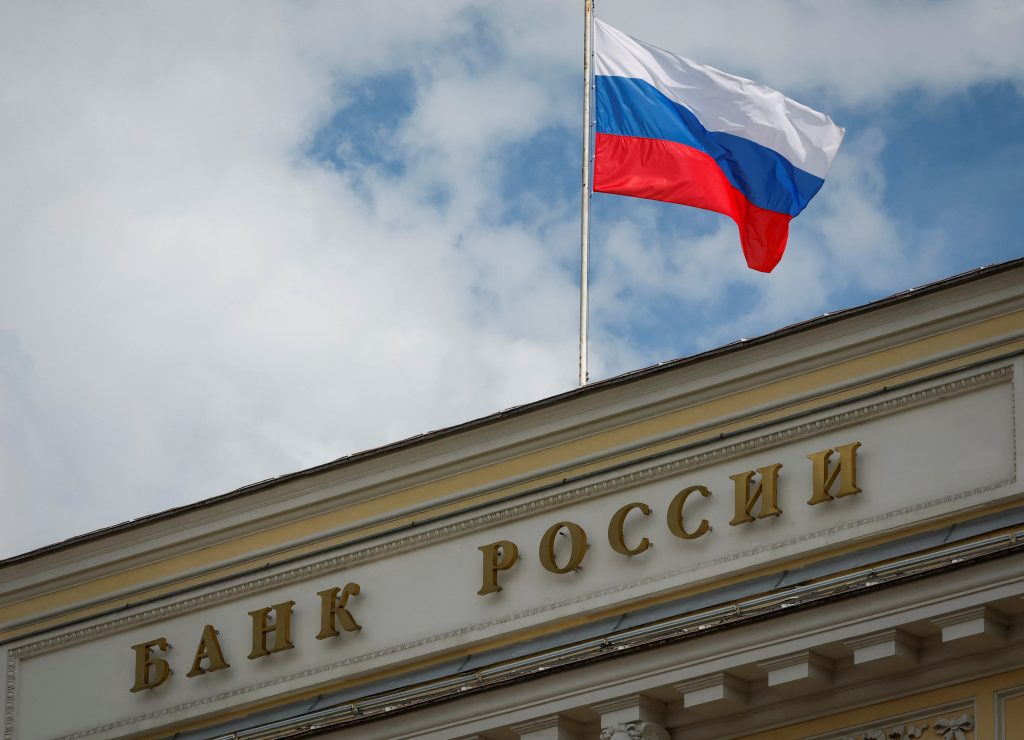
Details: As the years following Putin’s disastrous invasion wind on—and as the Russian economy spins toward collapse, with Moscow’s increasing irrelevance as a geopolitical player—it becomes clear to those in the Kremlin and elsewhere that there is no damage Putin isn’t willing to incur in his messianic mission to bring Ukraine to heel. Little matter that Western unity isn’t folding, or that Ukraine’s accession into the European Union is formalizing Kyiv’s Western trajectory. For Putin, victory is just around the corner.
That is, until a cadre of Kremlin insiders gather in his office, and it isn’t. In scenes reminiscent of Nikita Khrushchev’s 1964 ouster, an internal putsch removes Putin from power. Feting the now-former president as a restorer of Russian greatness, and as a worthy heir to imperial predecessors, the new regime nonetheless shunts Putin to the side, offering him a gilded retirement within his Black Sea palace, and pledging to never prosecute the former president (though that pledge does not necessarily apply to his closest allies).
Soon, the new regime—helmed by a small number of Western-trained, technocratic elites—begins implementing a range of post-Putin policies. They sound out potential diplomatic channels in the West, putting out feelers to those in Washington, London, Brussels, and even Kyiv. The new officials steering decisions in the Kremlin rescind previous Russian policies extending presidential terms, announcing snap elections scheduled for later that year. They likewise free some political prisoners and opposition politicians—though they pointedly refrain from reducing Alexey Navalny’s sentence, citing concerns about interfering in the Russian judiciary.
In public pronouncements, the new regime neuters nationalistic rhetoric. While they refrain from criticizing Putin outright, they nonetheless gesture at vague “mistakes” Russia had made in previous years, which they would seek to correct. With the conflict in Ukraine effectively frozen, they use Track II diplomacy to float a potential land-for-peace resolution to the conflict: retaining Crimea, but removing Russian troops from the remainder of Ukraine, while likewise rescinding Putin’s September 2022 annexations. And domestically, the new officials in the Kremlin announce an end to Putin’s autarkic lurch. They continue to protest the West’s freeze of Russian Central Bank assets, but they begin organizing meetings in Washington and Brussels to discuss means of lifting both sanctions and price caps.
All of it was, to many in the West, welcome. Such a new regime is not democratic, per se; but the new regime, led by a placeholder without an independent base of support—say, current Prime Minister Mikhail Mishustin—would continue, even after the snap elections. But markets respond positively, as do a range of Western policymakers who call to give this “new Russia” a chance. An array of Western public relations experts swoops in, launching campaigns to highlight the regime’s “reformist” credentials. In backroom discussions, Russian officials begin expressing frustration to Western partners about Moscow’s “junior partner” role vis-à-vis China, and highlighting the role the Kremlin could play as a potential counterweight to Beijing.
And one word—a word that hadn’t been seen in years—begins floating around again: reset. Not like those resets seen previously, most especially (and notoriously) in 2009. But a real, honest reset. That’s what could emerge between this “new Russia” and the West (absent Kyiv, at least). A reset, finally done right. A reset that could actually, for the first time, work. Right?
Strategy and policy prescriptions: There’s reason to find appeal in any scenario that sees the replacement of Putin with a technocratic, reformist regime. Indeed, many of the topics mentioned in this scenario—removal of Russian forces from Ukrainian territory; annulment of 2022 annexations; lifting of restrictions on civil society and political opposition—should be encouraged.
However, despite the appeal of such progress, any optimism about a potential technocratic shift should be tempered. Not only would such a scenario fail to guarantee the success of Western strategy in Ukraine—that is, the new regime would likely insist on some form of sovereignty over the Crimean peninsula—but it would fail to pursue either full-scale lustration or large-scale democratic reforms. Rather than assigning culpability for Russia’s war in Ukraine to the nation itself, such a technocratic regime would rather place responsibility upon Putin and his inner circle. And rather than pursue reparations and restorative justice regarding Ukraine, such a regime would not only decline such calls, but claim that both topics were nonstarters.
There would be plenty of Westerners who see such progress as a means of restoring relations with Moscow to a status quo antebellum. And to be sure, such a reformist regime would be a significant improvement over its Putinist predecessor. The war would be, for all intents and purposes, over.
And yet, this is a story that many in the West have seen before: Russia may not be a democracy, the claims go, but it was “transitioning.” And it may not offer full property rights or an impartial judiciary, but it was nonetheless open for Western investment.
As we know, every time this reset-based approach has been pursued, Western interlocutors have ended up appearing foolish, myopic, or both. With all previous iterations ending in friction and frustration, such a reset-based strategy must be treated with severe skepticism. And while such democratic reforms should be encouraged and incentivized—such as by predicating sanctions relief on lifting restrictions on civil society, or on reparations for Ukraine—any improvements should be treated as temporary.
To paraphrase a previous administration: should a new, technocratic regime emerge from the rubble of Putinism, the strategy is simple: distrust, but verify. The policy slate should include a number of the containment measures mentioned above, not least as a hedge against Russia’s potential return to revanchism—and as a price for any continued occupation—but dialogue should commence, with a clear signal of a willingness to address ongoing concerns.
Time horizons and likelihood: While such a scenario cannot be dismissed out of hand, it is hardly likelier in the near term than Putin’s retention of power, or even a rightward putsch installing a nationalistic regime. However, and for many of the strategic and geoeconomic reasons outlined in Scenario #2, the likelihood of a reformist, technocratic government emerging in Moscow increases in likelihood over the medium term. Indeed, one factor that may make this scenario more likely than the nationalistic turn over the medium term is support and encouragement from Western partners, who will seek to offer swift recognition of any cadre bearing such reformist credentials.
But Western partners, for all the reasons listed above, should be careful—or, at the least, should be careful what they wish for. After all, in the early 2000s, Western partners were happy to back a new president rising who pronounced a willingness to pursue economic and even potentially political liberalization. Nearly a quarter of a century later, that president remains in power and is now the author of the greatest bloodshed Europe has seen since World War II.
Scenario #4: Democratic Russia returns home
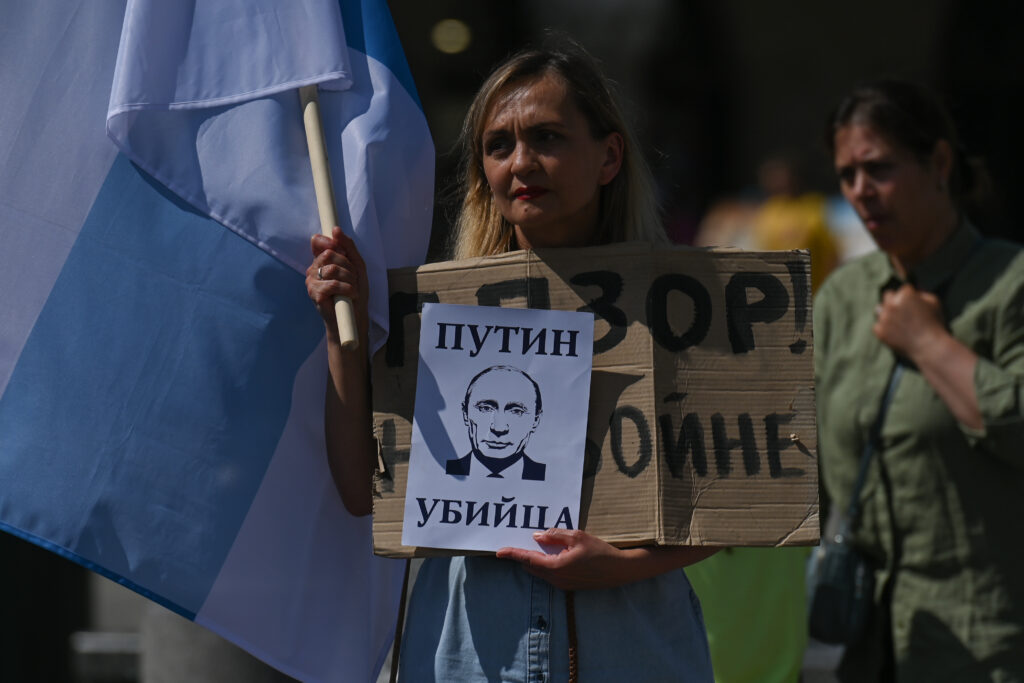
Details: Years after launching a series of bloody, futile wars across its former colonial space, protests erupt around the country, demanding change. Too many of the protesters’ compatriots had already died, carried home in coffins from lands no longer theirs. Global pressure, especially from the West, becomes too much to bear. And, with coffers draining, the national economy teeters, bringing back memories among the older generations of previous economic ruin. It is time for something new. It is time, at last, to put these neoimperial dreams to bed. And it is time, at last, for democracy.
For those who study comparative imperial formation and, especially, imperial collapse, it is a familiar story. It is a playbook that was seen in the British Empire, undone by Irish republicans in the 1910s and by Indian patriots in the 1940s. It is a story seen in France, battered by failures in Algeria and Vietnam in the mid-twentieth century. It is a story seen in Portugal in the 1970s, when the vestiges of Lisbon’s southern African empire finally achieved independence. It is a story that European empire upon European empire had already experienced, effectively killing off the vestiges of imperial sentiment and any remaining revanchist tendencies in the former empires.
And now, thanks to Ukraine’s victories, Putin’s cascading failures, and economic ruin in the offing, it is Russia’s turn to experience the story. And Russia, just as every former European empire elsewhere, does not disappoint. Indeed, there is plenty of reformist history for Russians themselves to build on. After all, some of the most remarkable moments of democratic change in Russian history—the end of serfdom in the 1860s, the creation of the Duma in the early 1900s—came after military defeats in foreign wars.
In echoes of similar movements in the 1980s and early 1990s, after another failed military adventure in Afghanistan, Russians witness failure in Ukraine, and once again march en masse for change. And not just in Moscow, but in Irkutsk and Vladivostok, in Tomsk and Arkhangelsk, over and over, gathering pace and force as they demand change. There is a world of disagreement: on economic policy, on judicial reform, on potentially joining an expanded European Union. But at their broadest, the protests center on three elements:
- Decentralization: unwinding the presidential powers, and amending Russia’s 1993 constitution to restore federalism and local sovereignties.
- Deconfliction: removing Russian armed backing of separatist polities in Moldova, Georgia, and especially Ukraine.
- Democracy: in the form of free and fair elections, at both local and national levels.
It is all so immediate, so swift, that Western policymakers can’t wrap their minds around it. It is a redux of 1989, or even 1991. This time, though, it is predicated on Russia’s colonialist, neoimperial failures, there for all to see. And this time, it comes with authorities in Moscow finally taking responsibility for the Kremlin’s colonialist crimes and an overdue recognition of Russia’s colonial legacies.
The final European empire has, at last, crumbled. And a post-imperial—and democratic—Russia emerges, ready to rejoin its European family.
Strategy and policy prescriptions: This outcome is among the best the West could possibly envision—and should be the one to incentivize, encourage, and accelerate. Opening dialogue on sanctions relief, especially related to domestic political and economic reforms, is a must. Providing investigative resources, such that a new Russian government can further investigate the crimes of the Putin regime and its allies, can also expedite a project of lustration. Rather than seizing frozen Russian Central Bank assets, the West can predicate their return upon Moscow sending reparations to Ukraine. The United States should likewise push to open further consular offices across Russia, including in Grozny, Yakutsk, Saint Petersburg, and elsewhere. Throughout, the West should provide diplomatic support for a broad array of democratic reforms—including the potential independence referenda proposed by Russian authorities—and offer the aid of constitutional experts from other parliamentary, federal democracies, including Canada and Germany.
All the while, the West must not—absolutely must not—get overexcited about such shifts taking place in Russia. More directly, the West must be especially attuned to any revanchist, neoimperialist rhetoric or posturing from Moscow. Indeed, it can be argued that ignoring the revanchism percolating around Boris Yeltsin’s and Vladimir Putin’s early years helped blind the West to the later imperialism saturating the Kremlin. Navalny, for instance, has a clear record of chauvinistic, neoimperialistic comments regarding non-Russian populations and former Russian colonies. While Navalny has largely recanted such statements, the West must be ever vigilant about any comments or related policies gaining credence and traction in Moscow.
In other words, the West should follow a simple policy: trust, but verify. Only then will Russia firmly enter its postimperial phase—and Europe will, at last, become whole, united, and free.
Time horizons and likelihood: While this scenario cannot be dismissed, it is unfortunately unlikely over the near and medium term. Given the decimation of Russian opposition parties and leadership, as well as the clear dearth of support from the broader Russian body politic, any dreams of a thoroughly democratic Russia in the foreseeable future are mere illusions.
However, over a longer time horizon—measured perhaps in decades, rather than years—such an outcome only grows in likelihood. The postimperial trajectories of Portugal, Spain, France, and other former European empires took decades to reach their completion. There’s no reason to think that Russia won’t follow a similar trajectory—or that it won’t eventually find its way to its European home.
Scenario #5: Chaos, civil war, and colonial freedoms
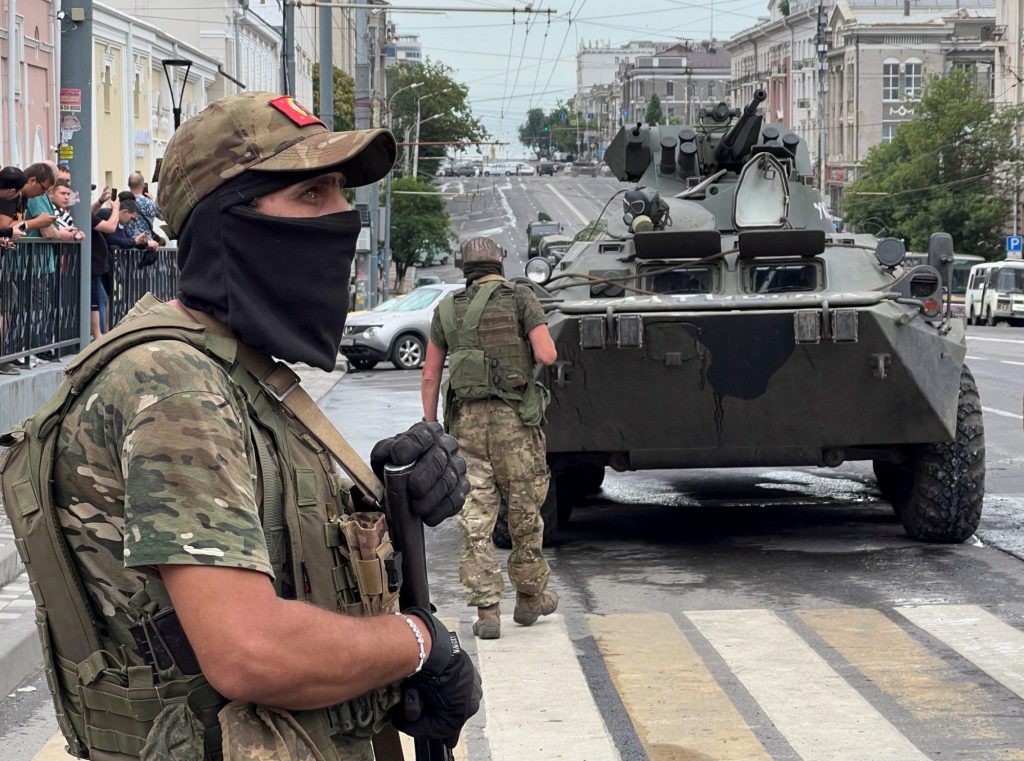
Details: Perhaps this was always inevitable. A country that refuses to recognize its brutal imperial history—a country that refuses to even recognize its role as a colonizer, obliterating and consuming surrounding nations—is always going to explode. Then factor in its geographic expanse, its crumbling economy, the exploding number of deaths in a senseless imperial war, the collapse of any kind of ruling legitimacy in the imperial metropole, and long-buried frictions and frustrations suddenly rippling across the country. A nation supposedly united under the steady hand of Moscow suddenly splinters, suddenly shatters, shredded along ethnonationalist lines—torn, as with other empires before it, between the colonizer and the colonized. Chaos sprints across the nation, which collapses into a mixture of anarchy, territorial fragmentation, and violence that leaves no region, and no family, untouched.
Such a scenario may, from the vantage of 2023, appear fanciful, almost fantastical. But it is a scenario that wracked Russia in the late 1910s and the early 1920s. It is a situation that unwound the Soviet Union in the late 1980s and early 1990s. And given the tinder Putin and his allies have built—from the failures in Ukraine to the imploding economy, to the targeting and in some cases terrorizing of minority populations, even to the rote refusal to acknowledge that Russia ever committed any colonial crimes—there’s little reason to think such a scenario cannot emerge in Russia once more, unleashing a frenzy of fracture and bloodshed across the empire yet again.
Indeed, it’s a scenario that’s increasingly easy to envision, especially as the twinned failures of Ukraine and the economy continue apace. Perhaps in Chechnya, an increasingly unhealthy Ramzan Kadyrov dies in office, and infighting over a successor spirals into a third Chechen War. Perhaps in Tatarstan, veterans’ committees and local students gather to protest both Moscow’s recruitment of Tatar infantry and smothering of Tatar identity—and the Kremlin, in a fit of failed strategy, opens fire on the protesters, sparking a broader anticolonial movement in Tatarstan. Or perhaps, in Sakha, unemployed Sakha men storm and seize control of Russian hydrocarbon infrastructure, demanding the funds be returned to their colonized nation, and demanding the sovereignty they agreed to in the early 1990s.
Again, these scenarios may all seem somewhat fanciful, insofar as Chechnya, Tatarstan, and Sakha have never enjoyed any kind of international recognition as independent polities—and Moscow has never evinced any interest in allowing them any kind of freedom.
But there are two points worth considering. First, all three colonies nearly obtained either full or near independence in the early 1990s. Chechnya, of course, is the most well-known example, with the Chechen nation decimated as a result. But in 1992, residents of Tatarstan clearly voted for full sovereignty, to be placed on equal footing with the Russian Federation. And Sakha leadership, in negotiations with Moscow, were promised in the 1990s everything from control of local revenues to the formation of a Sakha army.
All three—as well as a range of other polities including Bashkortostan, Dagestan, Buryatia, and more—watched their efforts at sovereignty collapse, undone by a renewed imperialism emanating from Moscow. And yet, all three of those efforts are within living memory. They’ve hardly dissipated, let alone disappeared. All it would take to renew such efforts would be the continuation of policies pursued by Putin—authored by the man who sees himself as the gatherer of Russian lands.
Given things like Prigozhin’s march and the increasing descent into conspiratorial mania from Putin, it is all too easy to envision a looming collapse of authority in Moscow, with an array of forces attempting to seize power. Perhaps that takes the form of the circa-1918 Russian Civil War, in which a competing array of anarchists, authoritarians (if not monarchists), fascists, and reformists launch putsch after putsch, destabilizing national policy. Distracted and destabilized, violence, tinged especially with anti-Russian animus, emerges once more in colonized republics, extending even to places like Tyva, Kalmykia, and Karelia. Declarations of independence rumble across Russia, and a parade of sovereignties once more emerges. All the while, militias congeal around Moscow, with no clear majority support from the broader Russian body politic.
History may not repeat; civil conflict may not claim the lives of tens of millions, and state collapse may not allow all of Russia’s current colonial holdings to gain their final freedom. But history can certainly rhyme. All empires, after all, collapse. And thinking Russia’s would be any different—that it wasn’t inevitable—was always going to be wishful thinking.
Strategy and policy prescriptions: On its face, such a scenario is potentially the most perilous of the paths forward for not only Russia, but for the West. While a range of concerns intersect with such an outcome, the overriding concern of such a path lies in the safety and security of Russia’s nuclear arsenal. Securing the stability of Russia’s nuclear arms must remain paramount as the West proceeds to navigate Russia’s fracturing polity. While the West successfully navigated a similar scenario during the Soviet collapse, such a precedent is not necessarily predictive in any future Russian state fracture. Where Kazakhstan, Belarus, Ukraine, and the Russian Federation were clear inheritors of the Soviet Union’s nuclear arsenal, such a clear line of ownership and control is not necessarily guaranteed should Moscow fall to infighting, and regions and nations colonized by Russian forces once more demand independence.
Such concern intersects with one of the other prongs of preparing for such a scenario: building links with regional elites, as well as regional opposition movements, that may act as inheritors of such an arsenal—and may be able to successfully navigate any Russian state degradation. Alongside the specific need to expand Tatar-, Sakha-, and Chechen-language education for Western policymakers, the West should focus on broader familiarity, political and otherwise, with these colonized nations. Constructing such links and networks can help mitigate the fallout of a power vacuum in Moscow—and help the West not only secure any loosening of nuclear security, but also craft the post-Putin, and potentially even post-Russian, futures of such polities. Strong consideration should be given to the potential for swift recognition of places like Chechnya, Tatarstan, Sakha, and others—so long as such polities exhibit clear signs of democracy and willingness to aid in nuclear security.
In such a fracturing Russia, priority should be given to a range of topics, from managing refugee outflows to economic instability. The West should focus on constructing third-party and multinational coalitions to manage not only nuclear stability, but also Russian instability more broadly. Working groups, diplomatic fora, multilateral meetings: a flexible array of multiparty policy groups should emerge. Policymakers can especially prioritize those with natural geographic connections, i.e. leaning on Turkish and Georgian partners to aid in conversations regarding the North Caucasus; Ukraine and Poland (and potentially post-Alyaksandr Lukashenka Belarus) regarding European Russia; Kazakhstan and Mongolia—if not China—regarding broader Siberia, and the like.
At its broadest, Western policy must avoid one overarching strategy: retaining the Russian Federation as it currently is, regardless of the cost. Not that this can’t be an outcome; should clear democratic consensus emerge for retaining both the structure and geographic limits of the Russian Federation, so be it. But in both the early 1920s and early 1990s, the West slow-walked and downplayed demands for aid and recognition from a range of nations still colonized by Russia. (Most tragically, Woodrow Wilson pointedly dismissed Ukrainians’ requests for recognition, convinced as he was that the Bolsheviks would soon be toppled.) It is a playbook that has resulted, multiple times, in a dictatorial regime that has pushed Europe, and the world, to the brink of nuclear catastrophe, all while decimating the broader Russian public’s political freedoms.
Flexibility, broadening the array of imaginable outcomes, and familiarizing ourselves with the Russian Federation as an empire: these are all elements of the strategy that should inform the West’s path forward. Perhaps most importantly, any efforts to avoid such an outcome should not impede Western efforts to ensure that Putin is defeated in Ukraine. That is, the West should not refrain from backing Ukraine because of outsized concerns of Russian instability.
Time horizons and likelihood: Such an outcome is, over the short term, hardly worth considering. However, and in similar fashion to the outcome that sees the rise of a liberal democratic Russia, the likelihood of such a potential path only increases as time passes, as Putin remains in power, as Russia’s economy degrades, and as Russia writ large fails to confront its imperial legacy. After all, no European imperial powers managed to retain their empires in perpetuity; why would Russia be any different?
Nor would such a transformation have to draw out over years. As seen in 1917-18, or in 1991, such tectonic shifts can take place in the blink of history’s eye. Such an outcome as outlined above need be no different—all of which is why the sooner the West begins digesting and preparing for such a potential fracture and destabilization (even if it never arises), the better off we, and future generations, will be.
About the author
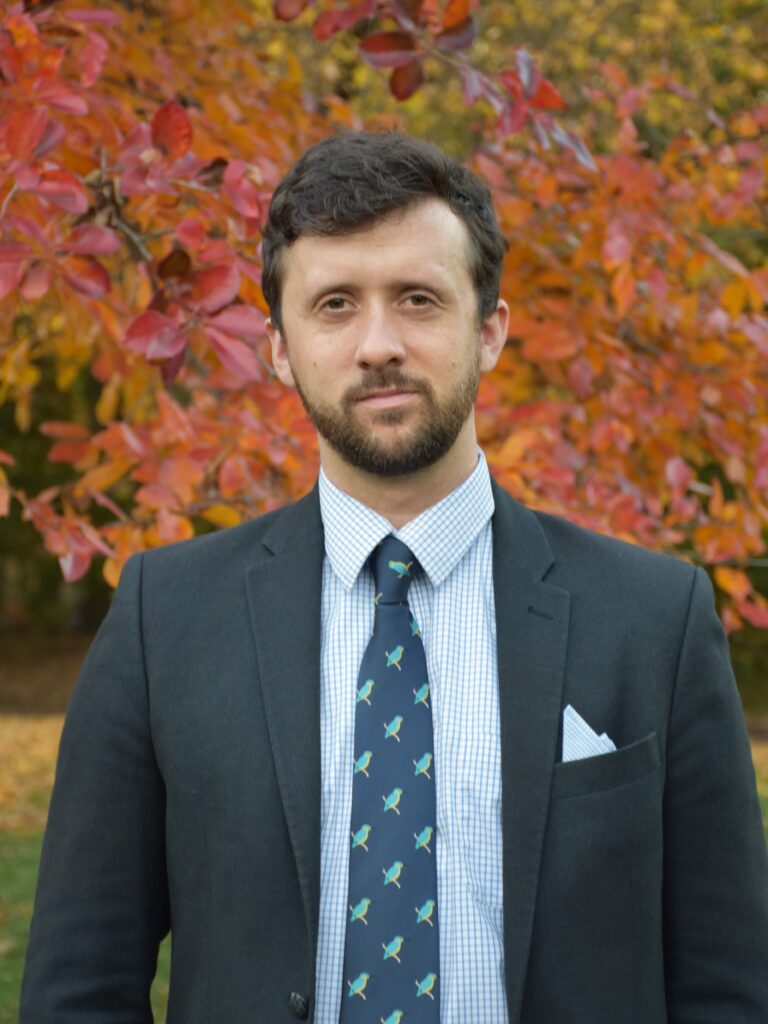
Casey Michel is an author, journalist, and director of the Combating Kleptocracy Program at the Human Rights Foundation. His writing on offshoring, foreign lobbying, authoritarianism, and illicit wealth has appeared in outlets such as the Financial Times, the Wall Street Journal, the Atlantic, Foreign Affairs, and the Washington Post, and has also been interviewed by news outlets on NPR, BBC, CNN, and MSNBC. He has also testified in front of the Senate Judiciary Committee on the links between illicit financial networks and national security. He received his master’s degree in Russian, Eurasian, and East European Studies from Columbia University’s Harriman Institute. He is the author of American Kleptocracy and of the forthcoming book Foreign Agents, both published by St. Martin’s Press.

The Eurasia Center’s mission is to promote policies that strengthen stability, democratic values, and prosperity in Eurasia, from Eastern Europe in the West to the Caucasus, Russia, and Central Asia in the East.
Related content
Image: Kremlin clock tower. (Olga Nayda/Unsplash)
